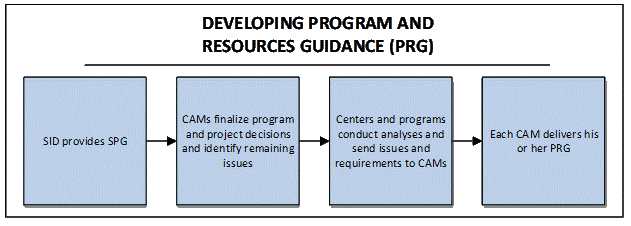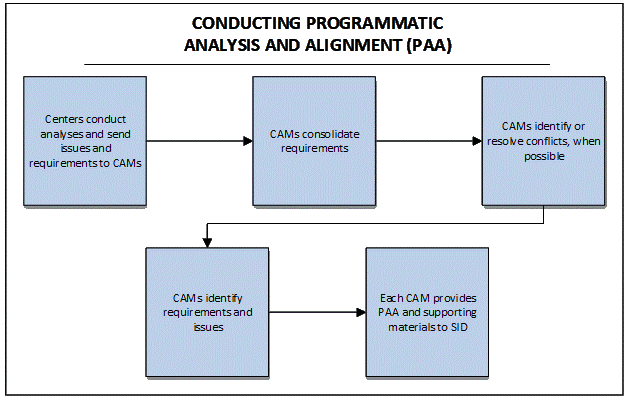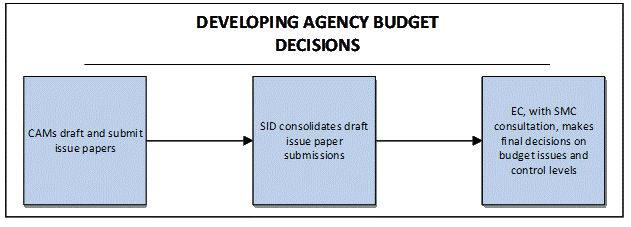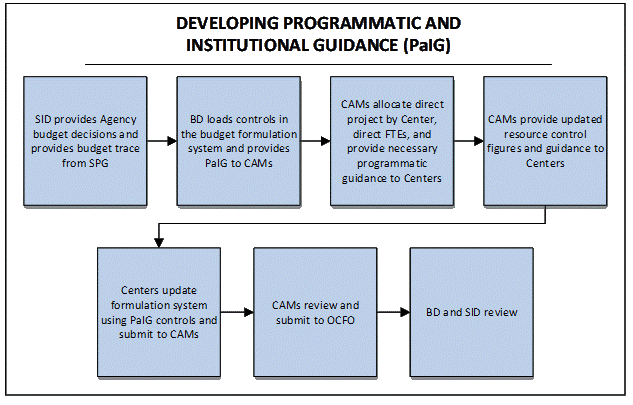
Procedural
Requirements
Effective Date: September 07, 2016
Expiration Date: September 07, 2026

|
NASA Procedural Requirements |
NPR 9420.1A Effective Date: September 07, 2016 Expiration Date: September 07, 2026 |
| | TOC | ChangeLog | Preface | Chapter1 | Chapter2 | Chapter3 | Chapter4 | Chapter5 | Chapter6 | AppendixA | AppendixB | AppendixC | AppendixD | AppendixE | ALL | |
3.1.1 The Programming Phase encompasses defining and analyzing programs and projects to optimize decisions and establishes the distribution of proposed budget authority among NASA accounts and programs according to identified priorities. Analyses include assessing multi-year resource implications, evaluating possible alternatives and impacts, and identifying and mitigating risks. By starting with top-level planning guidance to identify and resolve conflicts, the programming decisions result in a more balanced distribution of resources, enabling the Agency to meet its goals.
3.2.1 Purpose. The PRG is an internal, pre-decisional document that provides account-specific budgeting guidance for program/project managers. The PRG uses the guidance described in the SPG and establishes funding controls at a lower level.
3.2.2 Process. CAMs develop the PRG for their contributing organizations, to include FTE allocation. CAMs may issue data calls to identify other within-account or cross-account requirements and present the information in the PRG. Refer to Figure 3-1, PRG Process.
3.2.3 Timeline. CAMs release their final PRG no later than one week after they receive the SPG.
3.2.4 Responsibilities
3.2.4.1 CAMs integrate account-specific requirements into the PRG and provide additional budget and FTE estimating guidance. CAMs update the budget formulation system and release the PRG to Centers and project managers.
3.2.4.2 Centers and Program Managers review CAM inputs in budget formulation system and begin to identify potential resource conflicts.
3.2.4.3 OCFO designated managers and analysts review PRGs.
Note: During PRG and PAA, managers should assume fixed controls at the account (or otherwise specified level). In a "zero sum" environment, resource additions or new requirements are offset with reductions elsewhere, so the control is maintained. Only after alternatives and risks/impacts are assessed do managers raise the issue for resolution at a higher level.

Figure 3-1, PRG Process
3.3.1 Purpose. The PAA process enables early account-level programming decisions and identifies significant resource conflicts. Issues and conflicts are described and formalized in an internal, pre-decisional document that PAA reports (sometimes referred to as budget proposals or issue papers) that provide background information and analyses necessary for senior leader decision making. The compiled set of reports is often referred to as an "Issues Book."
3.3.2 Process. Centers and organizations align programs and projects to resources and identify new initiatives, risks, and misalignments. CAMs will develop PAA reports that include budget proposals, SPG deliverables, potential overguide requirements, and any other identified issues. OCFO SID conducts Agency-level analyses and develops a consolidated Issues Book for the SMC. Refer to Figure 3-2, PAA Process.
3.3.3 Timeline. Stakeholder organizations develop PRG responses upon receipt of the PRG. Generally, Center programs and mission support offices provide input to CAMs in April, and CAMs complete PAA reports in late May. In June, OCFO SID begins PAA issues analysis and AMPM and Agency cross-cutting analyses and develops material for EC consideration in July.
3.3.4 Responsibilities
3.3.4.1 CAMs complete PAA reports and include inputs from program/project managers, other CAMs, and institutional or other cross-cutting reviews. CAMs identify issues and resolve resource conflicts at the lowest possible levels. For issues not resolved within the account, CAMs explain conflicts and required adjustments to previously established resource levels and plans and work with OCFO SID to provide materials to support EC decision making.
Note 1: CAMs consolidate inputs from stakeholder organizations and conduct additional analysis at the account level. This may include developing top-level resource plans for Agency priorities and multi-year projects/activities; identifying any surplus or deficit capabilities and capacities, including workforce; assessing the impact of funding levels; recommending alternate strategies; and justifying any need for resource increases. In identifying conflicts, CAMs will include supporting information to support senior leadership decision making, including program overviews, funding and FTE requirements, and proposed resource adjustments and rationales.
Note 2: To ensure informed decisions, CAMs also provide project performance commitments, schedules, and progress to date; updates on AMPM milestones; supporting information on insufficient or surplus capabilities; analyses of alternate funding scenarios and impacts; risk assessments; discussion of alternatives considered but not taken; and description of the institutional and infrastructure impact on Centers based on additional or reduced resources.
3.3.4.2 OCFO SID reviews PAA reports and identifies significant issues for senior leadership resolution. OCFO SID develops the Agency-level AMPM and develops decision trade space for EC deliberations, as requested. To facilitate discussions, OCFO SID may produce an Issues Book with SMC member-provided options (and impacts).
3.3.4.3 Program and Project Managers, Centers, and Mission Support Offices provide supporting materials to the CAMs and identify issues.

Figure 3-2, PAA Process
3.4.1 Purpose. The EC makes decisions on issues raised during the planning and programming phases. Decisions generally affect the account- and Agency-level budget and civil-service workforce requests for its budget request to OMB.
3.4.2 Process. The EC conducts an Agency Budget Submit Decision Review to make and document final decisions on control levels, policies, priorities, trades, and other strategies. Senior leaders balance the needs of the programmatic Mission Directorates with resources available, achieve a strategic balance between programmatic and institutional needs, and optimize the capabilities and capacities across the Agency. When required, the EC determines which priorities will be included as overguide requests in the OMB Submit. Refer to Figure 3-3, Agency Budget Submit Decision Process.
Note: Generally, prior to Agency Budget Decisions, OMB provides a budget guidance memorandum. NASA leaders take this guidance under advisement when making budget decisions and determining the OMB Submit.
3.4.3 Timeline. OCFO SID works with EC to initiate this process in July.
3.4.4 Responsibilities.
3.4.4.1 EC conducts the Agency Budget Submit Decision Review to assess potential impacts/risks and make budget decisions.
3.4.4.2 OCFO SID organizes the review and presents Agency issues and options. OCFO SID also ensures decisions are documented and distributed to the CAMs.
3.4.4.3 CAMs provide information necessary for EC decision making.
3.4.4.4 OCFO BD updates the budget formulation database with resource allocations based on EC decisions.

Figure 3-3, Agency Budget Decision Process
3.5.1 Purpose. The PaIG is an internal, pre-decisional document that provides to CAMs a trace of changes from SPG budget and workforce levels through EC decision making. It is the basis from which CAMs allocate resources to program/project and Center levels for the OMB Submit.
3.5.2 Process. Organizations use budget controls from the Agency Budget Submit Decision Review to allocate resources to programs and to projects by-Center. Refer to Figure 3-4, PaIG Process.
3.5.3 Timeline. PaIG development begins immediately after EC Agency Budget Submit Decisions, usually in late July, or early August. The PaIG is typically released within two weeks of EC Agency Budget Decisions.
3.5.4 Responsibilities.
3.5.4.1 OCFO SID develops the PaIG and budget decision trace.
3.5.4.2 OCFO BD (working with CAMs) updates the budget formulation database with PaIG budget and FTE estimates.
3.5.4.3 CAMs allocate direct budget and workforce resources to projects and Centers, to be consistent with the workforce allocation process. CAMs ensure lower-level inputs are aligned to programmatic and institutional decisions and map to PaIG levels.
3.5.4.4 Program and Project Managers, Centers, and Mission Support Offices respond to CAM direction to adjust budgets, FTE estimates, and labor pricing entries in the budget formulation database.
3.5.4.5 OCFO SID develops and provides budget changes and any other required guidance following EC Agency Budget Submit Decisions.

Figure 3.4, PaIG Process
| TOC | ChangeLog | Preface | Chapter1 | Chapter2 | Chapter3 | Chapter4 | Chapter5 | Chapter6 | AppendixA | AppendixB | AppendixC | AppendixD | AppendixE | ALL | |
| | NODIS Library | Financial Management(9000s) | Search | |
This document does not bind the public, except as authorized by law or as incorporated into a contract. This document is uncontrolled when printed. Check the NASA Online Directives Information System (NODIS) Library to verify that this is the correct version before use: https://nodis3.gsfc.nasa.gov.